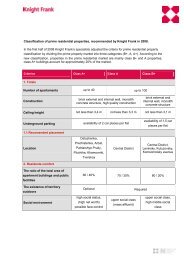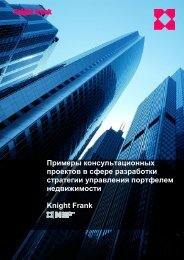COMMERCIAL REAL ESTATE MARKET - Knight Frank
COMMERCIAL REAL ESTATE MARKET - Knight Frank
COMMERCIAL REAL ESTATE MARKET - Knight Frank
Create successful ePaper yourself
Turn your PDF publications into a flip-book with our unique Google optimized e-Paper software.
2009<br />
Commercial<br />
real estate market<br />
Moscow<br />
Balance of payments and<br />
international reserves<br />
A more than 70% increase in oil prices during 2009 has supported Russia's economy<br />
$/burrel<br />
Positive signals regarding the development<br />
of major economies, which began to appear<br />
towards the end of Q1 2009, provided<br />
significant support for the global oil market.<br />
A steady growth in quotes for oil futures<br />
began already in May 2009. The Brent oil<br />
price for the year increased more than 70%,<br />
reaching nearly $78 a barrel. Similar price<br />
levels were typical for the market about<br />
2 years ago in the second half of 2007.<br />
Favorable energy prices, whose share of<br />
Russia's exports in 2009 amounted to about<br />
63%, provided a favorable balance of trade<br />
for the country up to 2009, amounting to<br />
$110.6 bln (versus $179.7 bln in 2008).<br />
85<br />
75<br />
65<br />
55<br />
45<br />
35<br />
01.01.09 02.03.09 01.05.09 30.06.09 29.08.09 28.10.09 27.12.09<br />
The positive current account balance in 2009<br />
has been estimated by the Bank of Russia<br />
$47.5 bln, which is two times less than the<br />
previous year’s amount of $102.4 bln.<br />
Despite the relative stabilization of the<br />
economy, a tendency towards the outflow of<br />
capital from the country remained in 2009,<br />
which amounted to $52.4 bln. However, these<br />
numbers are not so grim as they were in 2008,<br />
when net capital outflow exceeded $130 bln.<br />
The capital account and financial account<br />
in 2009 recorded a negative balance of<br />
$45.2 bln.<br />
Thus, the favorable development of oil prices<br />
and the decline in net capital outflows from<br />
Russia in 2009 provided a positive balance of<br />
payments for the country, allowing the Bank<br />
of Russia to increase international reserves to<br />
almost $12 bln for the year – up $439 bln.<br />
Moreover, Russia has managed to not only<br />
avoid additional external borrowing, but<br />
also has managed a 2.1% reduction in total<br />
external debt, which the Bank of Russia has<br />
estimated at $469.7 bln as of 1 January 2010,<br />
including $44.3 bln in public external debt<br />
and $425.4 bln in external debt for the private<br />
sector.<br />
Source: ICE, 2010<br />
Stock market<br />
As a result of a stabilized world economy,<br />
which came to be in about March 2009,<br />
investors began to gradually withdraw capital<br />
from risk–free assets, generally creating<br />
resurgence on stock markets and causing stock<br />
quotes of Russian issuers to go up. Following<br />
2009 the RTS index grew 128.6% and the<br />
MICEX index grew 121.1%.<br />
Considering 2009 growth rates, Russia's stock<br />
market took first place in world rankings. This<br />
Rising energy prices have provided an<br />
increase in trade surpluses for Russia<br />
since Q2 2009<br />
$ bln<br />
60<br />
50<br />
40<br />
dynamic, however, should not instill excessive<br />
optimism, considering that results from 2008<br />
were the most significant decreases in quotes<br />
recorded on the Russian stock exchanges (RTS<br />
index fell 72.4% and MICEX fell 67.2%).<br />
Among developed economies, the greatest<br />
increase in 2009 was demonstrated by the<br />
stock markets of Singapore (+64.5%) and<br />
Hong Kong (52.0%). NASDAQ, an index of<br />
high–tech companies in the U.S. took third<br />
place with an index value that increased<br />
43.9%.<br />
The volume of net capital outflows from<br />
Russia in 2009 has more than halved<br />
compared to 2008<br />
$ bln<br />
100<br />
50<br />
0<br />
The “external debt / GDP” ratio for Russia in<br />
2009 amounted to about 38% and “external<br />
debt / exports” amounted to about 136%,<br />
while a dangerous state of external debt<br />
according to international practice is<br />
considered to be in excess of its volume at<br />
50% of GDP or 220% of exports. Thus, Russia’s<br />
debt burden remains at an acceptable level<br />
and no significant concerns are extant.<br />
30<br />
20<br />
10<br />
0<br />
Q1 Q2 Q3 Q4<br />
50<br />
100<br />
150<br />
Q1 2008<br />
Q2 2008<br />
Q3 2008<br />
Q4 2008<br />
Q1 2009<br />
Q2 2009<br />
Q3 2009<br />
Q4 2009<br />
2008<br />
2009<br />
Source: Bank of Russia, 2010<br />
Source: Bank of Russia, 2010<br />
32


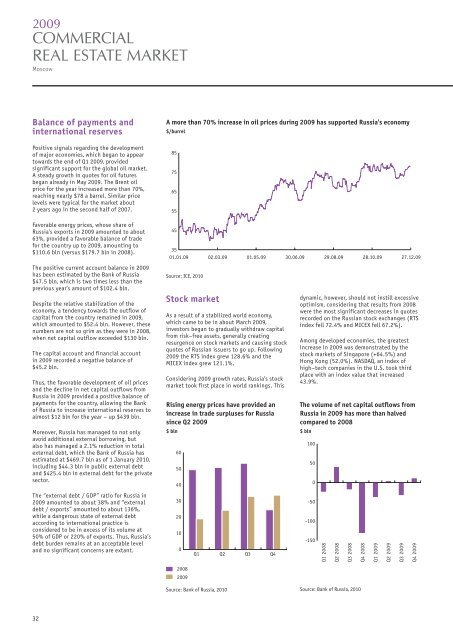

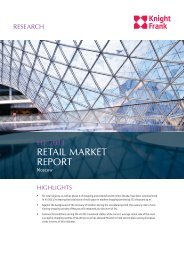


![[PDF] ÐÑогÑамма меÑоÐÑиÑÑÐ¸Ñ - Knight Frank](https://img.yumpu.com/43099779/1/184x260/pdf-n-3-4-n-1-4-1-4-1-4-un-3-4-nnnn-knight-frank.jpg?quality=85)
![[PDF] Ð Ñнок коммеÑÑеÑкой недвижимоÑÑи - Knight Frank](https://img.yumpu.com/36235407/1/184x260/pdf-n-1-2-3-4-3-4-1-4-1-4-unnun-3-4-1-2-u-1-4-3-4-nn-knight-frank.jpg?quality=85)
![[PDF] ÐлиÑÐ½Ð°Ñ Ð¶Ð¸Ð»Ð°Ñ Ð½ÐµÐ´Ð²Ð¸Ð¶Ð¸Ð¼Ð¾ÑÑÑ - Knight Frank](https://img.yumpu.com/35569291/1/184x260/pdf-n-1-2-n-n-1-2-u-1-4-3-4-nnn-knight-frank.jpg?quality=85)
![[pdf] ÑÑнок оÑиÑной недвижимоÑÑи - Knight Frank](https://img.yumpu.com/34340947/1/184x260/pdf-nn-1-2-3-4-3-4-nn-1-2-3-4-1-2-u-1-4-3-4-nn-knight-frank.jpg?quality=85)
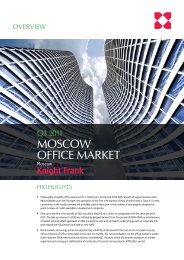
![[PDF] СкладÑкой ÑÐµÐ³Ð¼ÐµÐ½Ñ - Knight Frank](https://img.yumpu.com/31048046/1/184x260/pdf-n-3-4-nu-1-4-u-1-2-n-knight-frank.jpg?quality=85)
